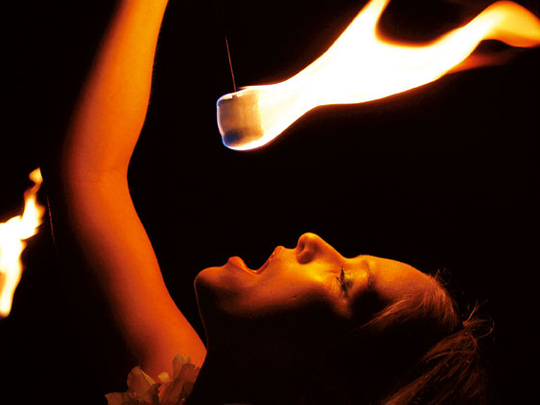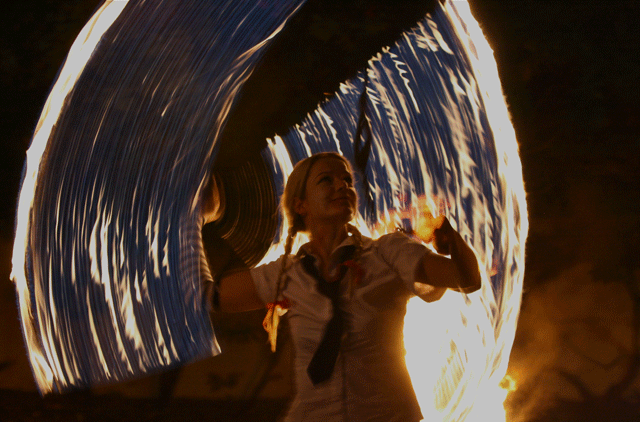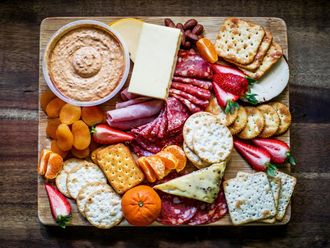
The reactions can range from shock to fascination and interest. I explain how I manoeuvre equipment around my body to music. I talk about fire breathing and blowing. I tell them that the fire equipment has wicks made of Kevlar [a kind of fibre], soaked in citronella oil.
You first practise fire dancing without the fire.
After you build enough confidence, you switch. I decided to do it the other way round.
This goes back to my university days in Cape Town where a bunch of students would chill out at the beach - drumming, fire dancing and playing guitar. It was a ritual every Monday night. Several amateur fire dancers, some better than the rest, would put up impromptu shows. I was entranced. As I watched one of my friends perform, I saw how beautiful the fire looked around her body.I loved the element of danger, and how everybody stopped to watch the movement of fire.
I tried it for myself.
I didn't use practice [fire dancing] equipment, unlike most beginners. I tried it directly with fire. It was exciting - an adrenalin rush. Obviously, I didn't want to burn myself. As a learner, you are very aware of the danger, and are extra careful. You make sure the fire doesn't touch you. After the first attempt, I had to practise the art and routine. Ironically, I have hurt myself using practice poi [wicks on chains] than with fire.
Later, I joined a professional group called Fire Tribe. From there on,I took my knowledge of fire dancing on my travels to South Korea, Japan, China, Vietnam, Cambodia, Laos, Malaysia, England, France, Italy, Greece, Hawaii, and now the UAE.It's been more than a decade thatI have been fire dancing, and I barely recall any burns.
Yet, I always carry a safety kit.
The kit has a fire extinguisher, fire blanket, anti-inflammatory spray, and after-burn cream. Just in case. Sofar I haven't had the need to useany of these.
Still there are rules in fire dancing. You have to take into account the weather and the direction of the wind. You have to make sure that your hands are far away from the flames. Surprisingly, the toughest part is choreography - getting the timing of the equipment and the music right. Fire can be an unpredictable element. Sometimes you practise a perfectly timed routine indoors, but when you perform outdoors, it's not the same. Occasionally, the equipment doesn't work well. Or the flame is unruly due to windy conditions. The audience, however, may not even notice. The movement of fire is mesmerising.
In the hierarchy of entertainment, a fire dancer is…
…at the same level as a juggler or magician. But it is the entertainment routine with the most impact. The
wow factor differs among a few nationalities. Asians, for instance, tend to chat or take pictures after our performance.
Over the years, we have witnessed improvements in equipment and routine. Traditionally, women have been drawn to the sensuality of fire dancing. Now we see more male fire dancers. In Dubai, there aren't many fire dancers so I think our team, WildFire Dancers, is pretty good. The more shows we [dancers from South Africa, Europe and Mexico] do, the better we get.
I have done more than 500 shows and feel I'm still learning. But when I see fire dancers back in Cape Town, I realise I can improve. It is the same with any art or sport - you can always get better.
I don't think of fire dancing as a task.
It is more of a hobby. It is fun. I perform at local events like beach parties, desert safaris and corporate functions. I get flown to perform in different countries.
Then there is the moneyelement. At times, I earn more through fire dancing than from aregular office job.
I meet interesting people too. Recently I met a French guy who speaks six languages. He does fire dancing, juggling and kids' events. Every time I meet him, he is doing something new, random. Of late, he has been teaching art and aqua aerobics.
Being a fire dancer comes with physical and mental demands. The equipment is heavy and your reflexes are constantly tested. You need focus.
There are times when I have tohold a particular position while the rest of the performers are in routine.It can also be strenuous, more so during the summer when you have to work with heat both from the fire and the environment.
I need to stay fit [to perform], but I engage in sports - like squash and swimming - for my own enjoyment. In fact, there are many areas of my personal and professional life that overlap. Take my visits to South Africa for instance. My family expects me to put on a show. It is the same when I am at a friend's birthday party. But I don't mind it.
I draw parallels between my regular job and that of a fire dancer.
My fire-dancing persona is a big part of who I am. Along with keeping me busy, it helps me maintain discipline to practise and perform several times a week. It requires people management as well.
As a manager in a Dubai-based construction company or as a member of a team of fire dancers,I deal with people. I believe it doesn't matter whether you are dealing with the CEO of a company or a magician at an event. When you speak to people, you have to be respectful.
But I think it is also important to find ‘me time' between your personal and professional life.
Pause, step back.
At the moment, I am studying for my MBA. If I am not studying for a degree or diploma, I am studyinga language. I can read and write Korean, and converse in Spanish and Italian. I play the guitar and experiment with photography.
It is all too easy to get caught up in the daily routine of life. Hence it is important to find or learn a new activity that will help you de-stress and enjoy life.
We don't get enough mental stimulation apart from what we do when we are at work. It could be an hour after work. It could be any activity. Pick something you haven't got around to doing, and before you realise it, you might have a new hobby or strike off another item from your to-do list.
Extra helpings
Fire dancing is also known as fire twirling, spinning or fire manipulation.
Fire dancers use equipment like single poi (wicks on chains); staff (long stick with wicks on either end); double and triple poi (long ropes of fire); fans; swords; and jump ropes.
During the summer, Monique Robinson and her team perform LED and laser shows in complete darkness.
Monique Robinson didn't study fire dancing formally. Her degrees have been predominantly in management and business development.











